How to bunny proof your electrical cords, cover and protect your wires with split length tubing and conduit to stop your bunny eating power cables
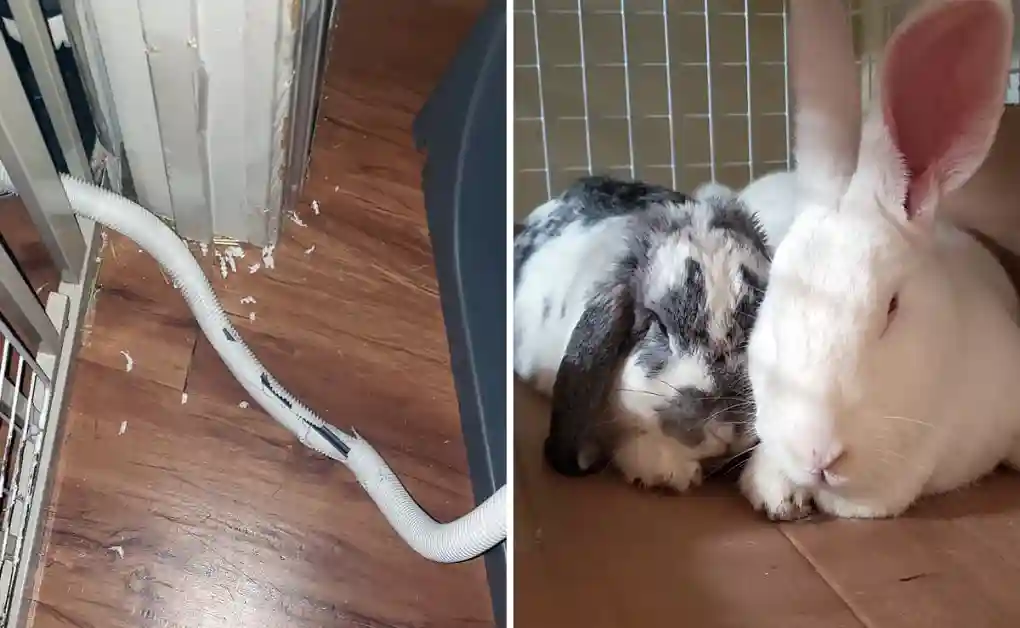
How to bunny proof your electrical cords, cover and protect your wires with split length tubing and conduit to stop your bunny eating power cables

It is important for your bunny's health and happiness that you spend plenty of time together. This time is often spent relaxing at home, watching TV, or surfing the web while allowing your bunny to roam freely in the room. However, the cables and cords that power these electrical devices can be dangerous, even deadly, for bunnies, who often find chewing them irresistible.
The soft plastic insulation on cables offers no protection against a bunny's razor-sharp teeth, which can slice through tough roots and shoots. If a bunny's wet mouth makes contact with the wires inside, they can suffer burns and severe electrical shocks. Additionally, the materials that power cords are made from can be harmful if ingested, leading to stomach issues and potentially costly trips to the vet.
To safely share your home with your bunny, it’s essential to fully bunny-proof all exposed electrical cables. In this guide, we'll teach you everything you need to know.
We have gained this expert knowledge from the contributions of the 50,000 members of our bunny-proofing Facebook group over the last 10 years who have shared their many problems and solutions on this subject.
We will show you straightforward ways to make a room safe by rearranging your furniture and using fencing made from sections of pet pens to keep power cables safely out of reach.
We’ll also provide guidance on installing permanent protection by covering power cords with split-length tubing or box conduit, so you never have to worry again.
We also have examples of how bunny parents have gone about blocking off the crawl spaces behind their TV which can be especially dangerous for a curious bunny.
Lastly, we will explore clever ways to keep phone and laptop chargers safe while still in use.
Don’t take chances. Learn how to complete this most important bunny-proofing task successfully so you can relax with your bunny roaming freely without needing to unplug everything first.
Before allowing your bunny to roam freely in a room, it is essential to ensure that all power cables are safely out of reach. Bunnies are expert chewers, and it only takes a moment for damage to occur.
Fortunately, making a room safe for your bunny is easy by making simple changes to how your furniture is laid out to hide the cables. With a few bits of fencing to cover the spots where power cables are left exposed, you can bunny-proof a room without much effort.
First, re-arrange your furniture and electrical devices to limit the amount of exposed cable your bunny can access. Position furniture with lamps or other devices directly in front of plug sockets, allowing you to conceal the electrical cords that run to them. Be sure to push the furniture up against the wall, as bunnies love to explore any gaps.
You can also run cables behind or over furniture by pushing pieces together. This way, you can stretch cables across the room to where you need them while keeping them safely tucked away.
Always remember that bunnies are good climbers and can jump high, so do a quick check to ensure they cannot find indirect ways to reach restricted areas.
Another straightforward method to bunny-proof cables is to fence them in. This can be done with sections of pet pen fencing or smaller wire grids taken from storage solutions, which can be used to shield areas with plugs or along walls. We recommend you avoid using cardboard as fencing as bunnies have a habit of chewing their way through this.
Wire fencing can also block off access to crawl spaces that lead to plugs under furniture or behind an appliance. Low sections of fencing can be easily made using sections of wire grids taken from office storage solutions which can then be lashed around the base of sofas beds and other furniture.
If you have a computer desk or shelves with numerous electrical devices, consider fencing off an entire corner or part of the room with sections of pet pen. Setting this up in a zigzag pattern makes it freestanding, or you can fasten the ends to some furniture with cotton string for added stability.
If you choose a pet pen with a gate section, it will be much easier to access the enclosed space when necessary.
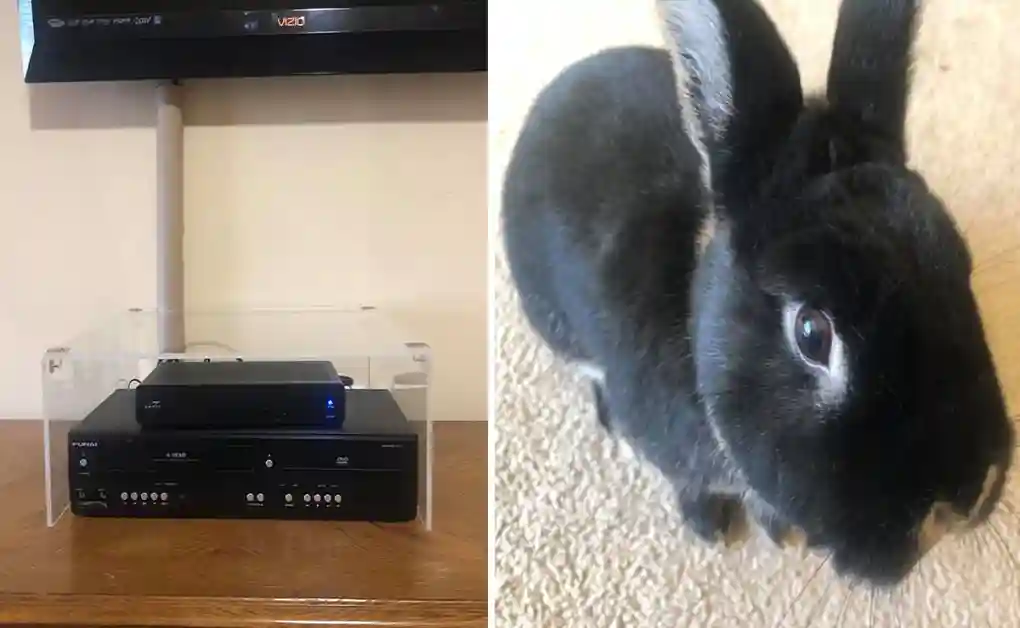





Sometimes it is hard to avoid wires that stretch across your room or to your appliances on a shelf or furniture. However, it is essential to ensure these cables are bunny-proofed before allowing your rabbit to roam freely in a room. Bunnies are natural foragers, and it’s likely that, sooner or later, they will chew on these wires, unaware of the potential dangers.
Unfortunately, relying on bitter sprays or scolding alone will not deter this behavior. The only effective solution is to find ways to protect the wires. Fortunately, many experienced bunny owners have tackled this issue, and this guide will outline various methods to accomplish this vital task.
A simple, convenient, and cheap way of adding protection, especially for short bits of exposed cable, is to slip them inside a length of plastic piping. We recommend using a tough solid pipe commonly used for plumbing, which can be purchased from home improvement or plumbing stores rather than a thinner, more flexible material. Some bunny parents have reported that their bunnies can chew through these less durable options.
If you’re unsure how to fit adapters and plugs through the pipe, the trick is to split the pipe lengthwise. This way, you can slip the cable inside without the need to remove the plugs. This can be done with care using a sharp knife. This type of tubing is often referred to as split-length tubing.

Another more permanent solution is to install conduits along the walls around the edge of the room. These tough strips of boxing or piping can be mounted above your baseboards, allowing you to hide electrical cables that would otherwise be exposed. Make sure you not only fit this around the room but also lead it down from any plug sockets and back up the wall to where electrical devices are located leaving no cables exposed.
Conduit can be installed without DIY tools It is affordable and readily available at most home improvement stores. The soft plastic can be easily trimmed to size, and these systems typically come with several corners and junctions that simplify assembly.
Lastly, if you can, consider keeping all your TV and audio equipment together in a cabinet. Cabinets with glass doors are ideal, as they allow you to keep everything safely hidden away while still allowing you to use your remote controls.
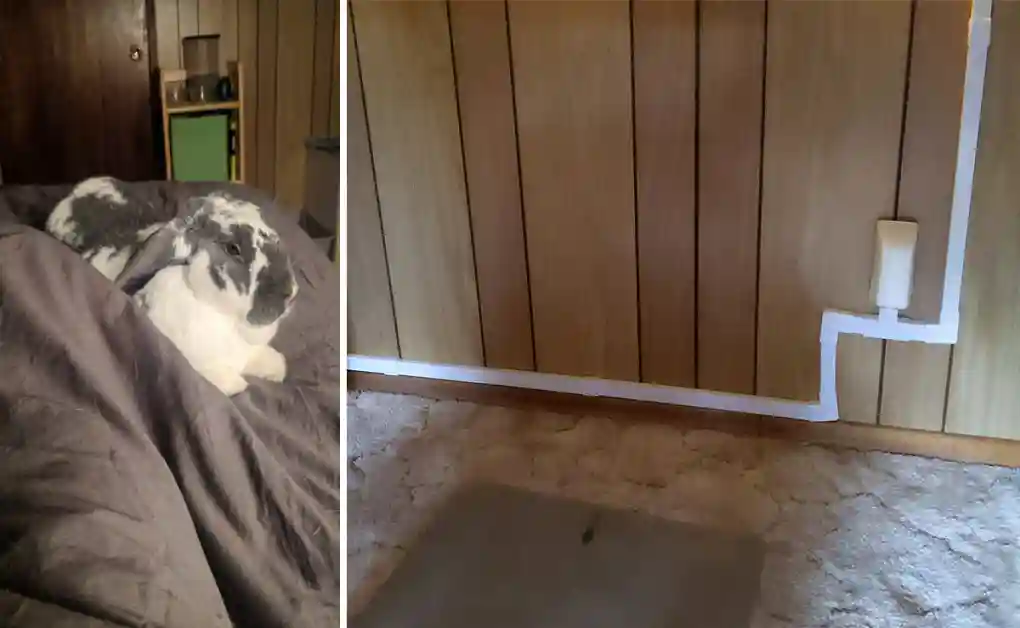


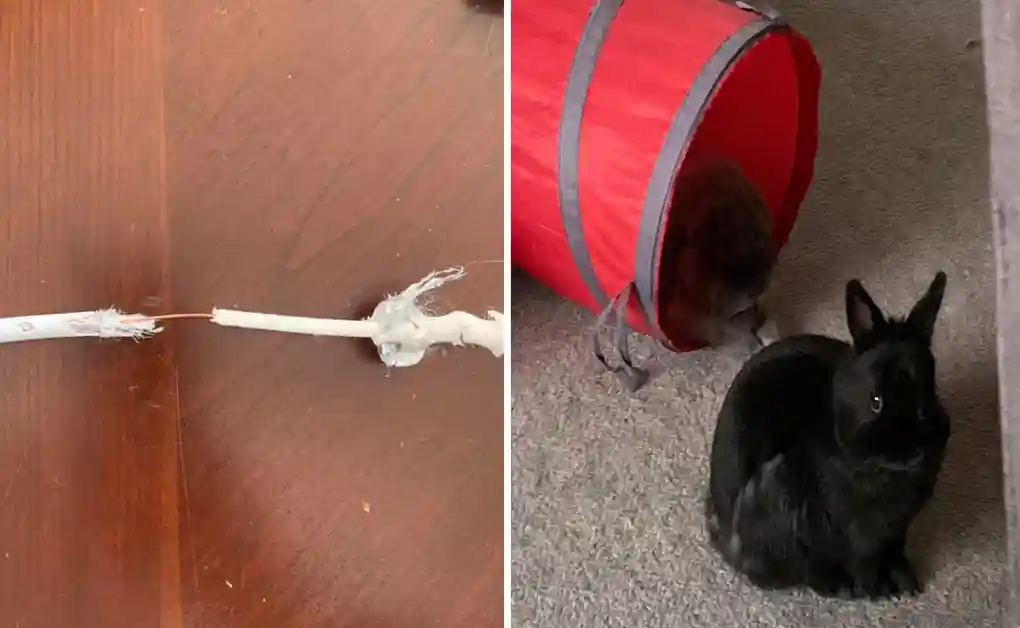
Bunnies love to explore and no amount of saying No will keep them out of forbidden areas like behind your TV when your back is turned. It is best to block this area off securely so the nest of electrical cables they contain is permanently out of harm's reach.
Position the TV up against a wall and in front of a plug socket so you don't need to trail any cables up to it, it's then just a matter of covering any gaps to block access behind. The corner of a room or tight-fitting alcove is an ideal place as this will create a natural space behind to put all the plugs and cables in that is blocked off at each side.
A few well-placed ornaments of pieces of furniture can often be enough to prevent access where needed, alternatively, you can use a couple of sections of a pet pen or the wire grids from office storage cubes to fence this space off around the edges or under a cabinet.
If you do have exposed audio cables or power cords then the safest way of protecting them is to hide them away. Wall-mounted conduit is ideal for doing this and it's available at home improvement stores which you can fit yourself. Elsewhere split ling pipe can be used to protect sections of cable.
It can help to keep all your TV and audio equipment together in a cabinet. Cabinets with glass doors are ideal as they let you keep the doors shut and still let you use your remote controls.
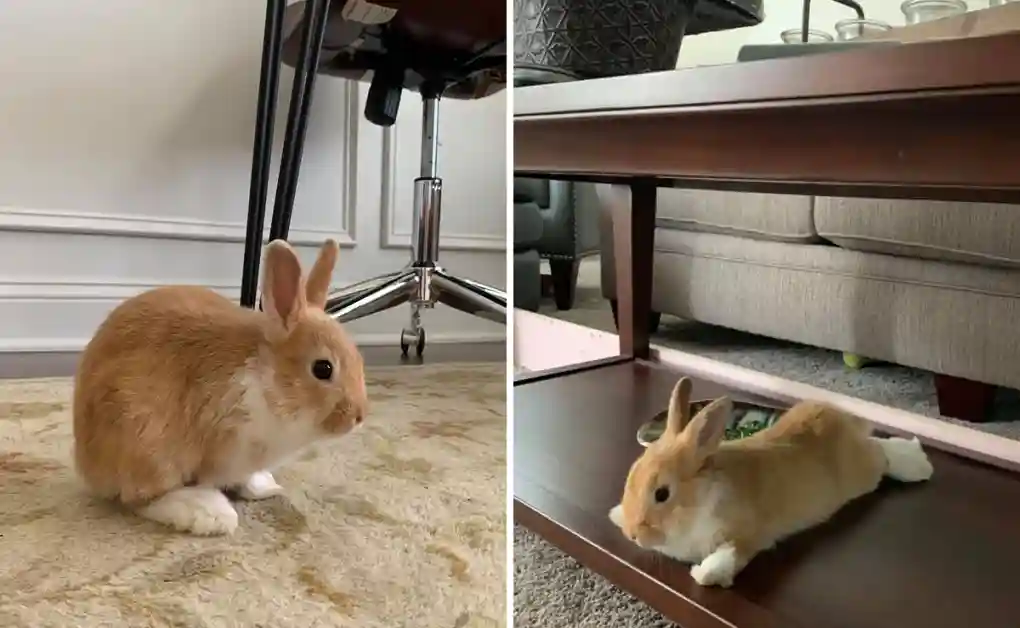





Rabbits have razor-sharp teeth that they use to chew through tough roots and shoots. They do this not only to eat but also to keep their burrows and paths clear of obstacles. Unfortunately, electrical cables are pretty much the same size as a root and shoot and they often lay in your bunny's path at the edges of the room where they run into them. This makes them almost irritable to rabbits to chew on and the moment they come across them their natural urge to chew through it is likely to take over.
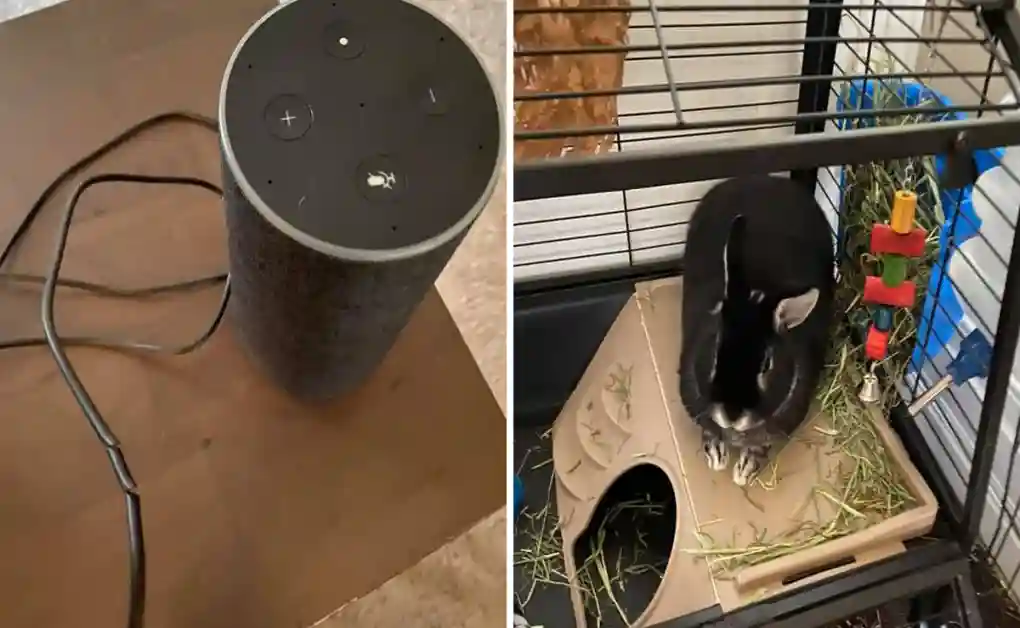
We often give our phones and other devices a lot of attention, and as a result, our bunnies may become curious about them when we put them down or leave them out. This curiosity can lead to scratched screens and broken charger cables.
The most effective way to keep these items safe is to move them out of reach and develop the habit of not leaving them unattended.
To help get in this habit of doing this it's best to set up a charging station in a location completely out of reach for your bunny, such as a kitchen countertop or a study where your bunny does not have access. Make it a routine to keep your gadgets in their designated spot when they are plugged in.
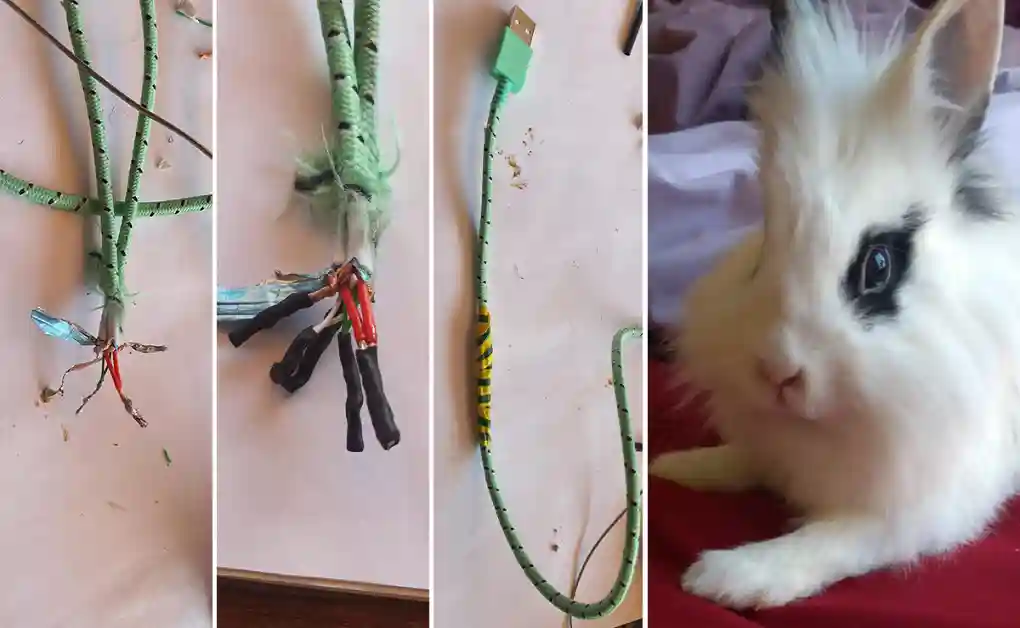

Yes, if your rabbit chews on power cables, it can burn their mouth and cause heart damage. It's important to protect cords permanently by using plastic piping or cable trunking.
Yes, bunny-proofing your electrical cords is essential to prevent your rabbit from chewing on them. Rabbits have sharp teeth that can easily chew through cords, posing a risk of electric shock.
To prevent your rabbit from chewing on wires, hide them in plastic piping or cable trunking. Additionally, make sure to block off access behind your TV.
Yes, it is quite common for rabbits to chew on wires. It is crucial to bunny-proof your power cords to keep them safe.
No, you should not allow your rabbit to chew on power cords. Doing so could result in a serious shock or burn to its mouth.
To prevent your rabbit from accessing cords, block them and outlets with furniture. Always ensure that the area behind your TV is inaccessible. You can also protect cords using plastic piping or cable trunking.
To protect your power cables from your rabbit hide them in plastic piping or cable trunking. Additionally, block off access behind your TV permanently. Move furniture in front of plug sockets and ensure the power cables are out of reach.
Position furniture in front of plug sockets and make sure the power cables are out of reach. For permanent protection, use split-length tubing or install cable trunking. Always block off access to wires behind your TV.
Place your TV against a wall and in front of the power outlet to avoid trailing cables. Permanently block access behind and under your TV stand using sections of pet pens or wire grids.